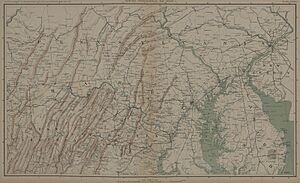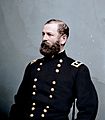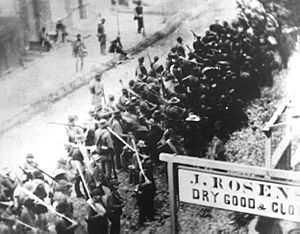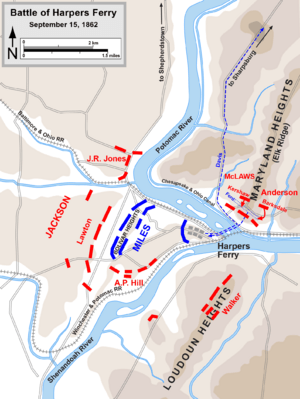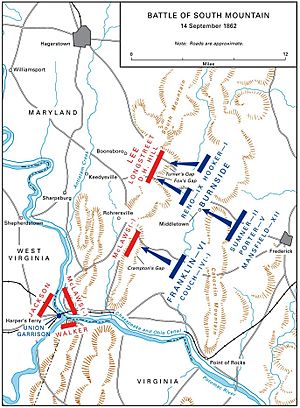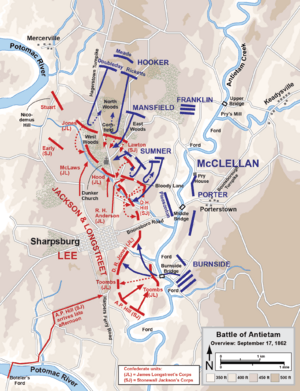Maryland campaign facts for kids
Quick facts for kids Maryland campaign |
|||||||
|---|---|---|---|---|---|---|---|
| Part of the American Civil War | |||||||
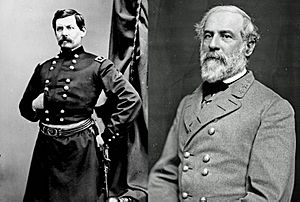 Union General George B. McClellan and Confederate General Robert E. Lee, the main commanders of the campaign |
|||||||
|
|||||||
| Belligerents | |||||||
| Commanders and leaders | |||||||
| Units involved | |||||||
| Army of the Potomac | Army of Northern Virginia | ||||||
| Strength | |||||||
| 102,234 | 55,000 | ||||||
| Casualties and losses | |||||||
| 28,272 total (2,783 killed; 12,108 wounded; 13,381 captured/missing) |
16,229 total (3,812 killed; 10,591 wounded; 1,826 captured/missing) |
||||||
The Maryland campaign, also called the Antietam campaign, happened from September 4 to 20, 1862. It was a major event during the American Civil War. Confederate General Robert E. Lee led his army into the North for the first time. However, Union General George B. McClellan and his Army of the Potomac stopped him. They met near Sharpsburg, Maryland. The battle that followed, known as the Battle of Antietam, was the single bloodiest day in American history.
After winning a battle in northern Virginia, General Lee marched his 55,000 soldiers north. This began on September 4, 1862. His main goals were to get supplies for his army and to lower the spirits of people in the North. He also hoped to influence the upcoming November elections. Lee took a big risk by splitting his army. Part of it continued into Maryland, while another part captured the Union base at Harpers Ferry. By chance, General McClellan found a copy of Lee's secret battle plans. This allowed McClellan to plan how to attack Lee's separated army.
While Confederate General Stonewall Jackson captured Harpers Ferry (September 12–15), McClellan's large army of 102,000 men moved quickly. They tried to get through the South Mountain passes. These passes separated McClellan from Lee. The Battle of South Mountain on September 14 slowed McClellan down. This gave Lee enough time to gather most of his army at Sharpsburg. The Battle of Antietam on September 17 was incredibly bloody. Over 22,000 soldiers were killed or wounded. Lee's army was outnumbered two to one. He moved his troops to defend against each attack. But McClellan never used all of his extra troops. This meant he missed chances to completely defeat the Confederates. On September 18, Lee ordered his army to retreat back across the Potomac River. Small fights by Lee's rear guard at Shepherdstown on September 19–20 ended the campaign.
Even though the Battle of Antietam was a tie in terms of who won the battlefield, it was a big win for the Union. It meant Lee's plan to invade Maryland had failed. President Abraham Lincoln used this Union success to announce his Emancipation Proclamation. This important declaration helped end any chance of European countries helping the Confederacy.
Contents
Why the Invasion Happened
War Situation Before the Campaign
The year 1862 started well for the Union in the East. General George B. McClellan's Army of the Potomac had moved into Virginia. By June, they were close to the Confederate capital, Richmond. But when Robert E. Lee took command of the Confederate army on June 1, things changed. Lee attacked McClellan's army hard in the Seven Days Battles. McClellan's army then retreated. Lee then outsmarted and defeated General John Pope at the Second Battle of Bull Run. Lee's Maryland campaign was the final part of his summer attacks.
The Confederate army had lost many soldiers during these summer battles. Still, Lee decided his army was ready for a big challenge: invading the North. His goal was to reach Maryland and Pennsylvania. He wanted to cut off the railroad line that supplied Washington, D.C.. His movements would also threaten Washington and Baltimore.
Lee had several reasons for invading. First, he needed to get supplies for his army. He knew Northern farms had not been damaged by the war, unlike those in Virginia. Moving the war north would also take pressure off Virginia. Second, he wanted to affect Northern morale. Lee believed the Confederacy didn't need to completely defeat the North. They just needed to make the North unwilling to keep fighting. With elections coming in November, Lee thought an invasion could help the Democratic Party. This might force Abraham Lincoln to end the war.
There were other reasons too. Lee hoped his invasion would cause people in Maryland to rise up. Maryland was a slave-holding state, and some citizens supported the South. Some Confederate leaders also thought a victory in the North would help other countries recognize the Confederacy.
After the Union defeat at Second Bull Run, President Lincoln turned to General George B. McClellan again. McClellan had fixed the army before, after the First Battle of Bull Run. Lincoln knew McClellan was good at organizing and training troops. He could quickly combine Pope's army with the Army of the Potomac. On September 2, Lincoln put McClellan in charge of defending Washington. Many in Lincoln's government disagreed with this choice. But Lincoln said, "We must use what tools we have."
The Armies Involved
Union Forces
| Union Corps Leaders |
|---|
|
General George B. McClellan's Army of the Potomac had about 102,000 soldiers. It included six main infantry groups, called corps. Many of these soldiers were new or had not fought much with the Army of the Potomac before. Some new soldiers had never even loaded their guns.
- The I Corps was led by Maj. Gen. Joseph Hooker.
- The II Corps was led by Maj. Gen. Edwin V. Sumner.
- The V Corps was led by Maj. Gen. Fitz John Porter.
- The VI Corps was led by Maj. Gen. William B. Franklin.
- The IX Corps was led by Maj. Gen. Ambrose E. Burnside.
- The XII Corps was led by Maj. Gen. Joseph K. Mansfield.
McClellan changed his army's structure during the march. He grouped corps into three "wings." But this was changed back before the Battle of Antietam.
Confederate Forces
| Confederate Corps Leaders |
|---|
|
General Robert E. Lee's Army of Northern Virginia had about 55,000 soldiers at the start of September. It was organized into two large infantry corps.
- The First Corps was led by Maj. Gen. James Longstreet.
- The Second Corps was led by Maj. Gen. Thomas J. "Stonewall" Jackson.
The army also had a Cavalry Corps, led by Maj. Gen. J.E.B. Stuart.
Lee's army was much smaller than it had been earlier in the summer. Many soldiers had been lost in battles or had left the army. Some soldiers refused to cross into Union territory. Many others got sick from eating unripe corn or had sore feet from marching without shoes. Despite being tired and short on men, the Confederate soldiers were experienced fighters. This gave them an advantage over some of the Union's new regiments.
The Invasion Begins
On September 3, Lee decided to cross into Maryland. The next day, parts of his army entered Maryland. By September 7, the main Confederate army was in Frederick, Maryland. Lee's invasion happened at the same time as other Confederate attacks in Kentucky. Confederate President Jefferson Davis explained that the South was not trying to conquer the North. Instead, they were trying to force the Lincoln government to let the South be independent.
Lee's invasion faced problems from the start. His army's numbers dropped from 55,000 to 45,000 in just 10 days. This was due to soldiers leaving or getting sick. When they entered Maryland, the Confederates found little support. Most people were openly against them. Lee was disappointed by this. Only a few dozen men joined his army in Maryland.
People in Maryland and Pennsylvania were very worried by the invasion. Pennsylvania's Governor called for 50,000 militia (citizen soldiers). In Maryland, panic spread quickly. People in Baltimore stocked up on food, fearing a siege.
Lee Divides His Army
Lee split his army into four parts as it moved into Maryland. He sent Maj. Gen. James Longstreet towards Hagerstown. Maj. Gen. Stonewall Jackson was ordered to capture the Union base at Harpers Ferry. This left only a small cavalry force and one division to guard the army's rear at South Mountain.
The exact reason Lee took this risk is not fully known. He might have wanted to control his supply lines through the Shenandoah Valley. Or, Harpers Ferry might have seemed like an easy target with many supplies. McClellan asked Washington for permission to move the Harpers Ferry soldiers to his army, but his request was denied.
McClellan's Chase
I did not believe before coming here that there was so much Union feeling in the state. ... The whole population [of Frederick] seemed to turn out to welcome us. When Genl McClellan came thro[ugh] the ladies nearly eat him up, they kissed his clothing, threw their arms around his horse's neck and committed all sorts of extravagances.
McClellan left Washington on September 7 with his 87,000-man army. He chased Lee slowly. McClellan was a careful general. He thought he was facing over 120,000 Confederates. His army's morale was low after recent defeats. But when they entered Maryland, the people welcomed them warmly. This boosted their spirits.
On September 13, McClellan's army reached Frederick, Maryland. There, a Union soldier found a copy of Lee's detailed battle plans, called Special Order 191. The order showed that Lee had split his army. This meant McClellan could attack each part separately. McClellan was very excited. He told a friend, "Here is a paper with which if I cannot whip Bobbie Lee, I will be willing to go home." He also sent a telegram to President Lincoln. But McClellan waited 18 hours before acting on this information. This delay cost him the chance to destroy Lee's army.
On the night of September 13, the Union army moved towards South Mountain. South Mountain is a natural barrier. Crossing its passes was the only way to reach Lee's army. Lee realized McClellan was acting aggressively. He might have also learned that his orders were found. So, Lee quickly moved to bring his army back together. He decided to make a stand at Sharpsburg, Maryland. Meanwhile, parts of his army defended the passes of South Mountain.
Key Battles of the Campaign
Harpers Ferry Battle
As Jackson's troops approached Harpers Ferry, the Union commander, Col. Dixon S. Miles, kept most of his soldiers near the town. He did not put them in strong positions on the hills around it. On September 13, Confederate attacks drove the Union troops from Maryland Heights, a very important position.
Other Confederate groups arrived and were surprised that key positions were not defended. Jackson placed his cannons around Harpers Ferry. By the morning of September 15, he had nearly 50 cannons ready. He began a heavy cannon attack and ordered an infantry assault. Miles realized they could not win and decided to surrender. He was badly wounded by a cannon shell before he could officially surrender. Jackson captured Harpers Ferry and over 12,000 Union prisoners. He then led most of his men to join Lee at Sharpsburg.
South Mountain Battle
On September 14, fierce battles took place for control of the South Mountain passes. Confederate General D.H. Hill defended Turner's and Fox's Gaps against Union General Burnside. To the south, General Lafayette McLaws defended Crampton's Gap against Union General Franklin. Franklin's troops broke through Crampton's Gap. But the Confederates managed to hold Turner's and Fox's Gaps. Lee saw that his position was hopeless against the larger Union army. He ordered his troops to Sharpsburg. McClellan could have destroyed Lee's army then. However, McClellan's slow actions on September 15 allowed the Harpers Ferry soldiers to be captured. It also gave Lee time to gather his scattered army at Sharpsburg.
Antietam (Sharpsburg) Battle
On September 16, McClellan faced Lee near Sharpsburg. Lee's army was defending a line west of Antietam Creek. At dawn on September 17, Union General Joseph Hooker's I Corps launched a strong attack. This began the very bloody battle. Attacks and counterattacks swept across a cornfield and woods near a church. Other Union corps joined the fight. Union attacks eventually broke through the Confederate center. But the Union army did not push their advantage. In the afternoon, Burnside's IX Corps crossed a stone bridge. They attacked the Confederate right side. At a key moment, General A.P. Hill's division arrived from Harpers Ferry. They counterattacked, pushing back Burnside's men. This saved Lee's army from being destroyed.
Lee used all of his soldiers, even though he was outnumbered two to one. McClellan, however, only sent in four of his six available corps. This allowed Lee to move his troops around and stop each Union attack. During the night, both armies strengthened their lines. Despite huge losses—12,401 Union soldiers and 10,316 Confederate soldiers—Lee continued to fight on September 18. He moved his wounded soldiers south of the Potomac River. McClellan did not attack again. After dark, Lee ordered his tired army to retreat across the Potomac into the Shenandoah Valley.
Shepherdstown Battle
On September 19, a group of Union soldiers crossed the river. They attacked the Confederate rear guard and captured four cannons. Early on September 20, more Union soldiers crossed the Potomac. General A.P. Hill's division counterattacked. They almost completely destroyed a Union regiment, causing 269 casualties. This fight stopped the Union from chasing Lee's army further.
What Happened After and Its Impact
Lee successfully retreated across the Potomac. This ended the Maryland campaign and the summer fighting. President Lincoln was disappointed with McClellan's actions. He believed McClellan's careful and uncoordinated attacks had led to a tie instead of a big Confederate defeat. Lincoln was even more surprised that McClellan did not chase Lee across the Potomac. McClellan gave reasons like lack of equipment. Lincoln removed McClellan from command of the Army of the Potomac on November 7. This effectively ended McClellan's military career. General Ambrose E. Burnside took command of the Union army.
Even though the Battle of Antietam was a tactical draw, it was a big strategic victory for the Union. It stopped Lee's invasion of the North. It also gave Abraham Lincoln the victory he needed to announce the Emancipation Proclamation on September 22. This proclamation became effective on January 1, 1863. Lincoln had wanted to announce it earlier. But his advisors told him to wait for a Union victory. This was so it wouldn't look like he was acting out of desperation. The Confederate loss at Antietam also stopped France and Great Britain from recognizing the Confederacy. With the Emancipation Proclamation, Lincoln made it clear that slavery was a key issue for the Confederacy. Since France and Great Britain were against slavery, they would not help the South.
The Union lost 15,220 soldiers during the Maryland campaign. This included 2,535 killed, 11,426 wounded, and 1,259 missing.
Images for kids


